Water Festival
A very Asian Based Festival known as Water Festival which westerners literally translates it. This Festival can be found mainly in south east Asian countries but however it may varies in the individual countries.
Countries that celebrate the water festival are as Follows :
1. Yunnan of China By the Dai Ethnic minority known as Pou Shui Jie
2. Myanmar / Burma known as Thingyan
3. Thailand / Siam known as Songkran
4. Laos known known as Pi-Mai
5. Cambodia known as Bonn Om Touk
6. Singapore : SIWF (Singapore International Water Festival)
The Dates of this water festival in the Year of 2011 for :
China, 14-16 April
Myanmar, 13-17 April
Thailand , 11-18 April
Laos, 13-15 April
Cambodia, 10-12 November
Singapore, 01 July
For this same festival, some of them are similar in certain places but some are very different in other places.
Let's begin with country at a time to see how this water festival varies or how much of a similarity it really is.
China
Let us first begin with, China

Po Shui Jie (潑水節) litery means water splashing festival is one that is celebrated only by the DAI ethnic minority (傣族) of Yunnan Province. Who are among one of the official and recognized 56 Ethnic groups of China.
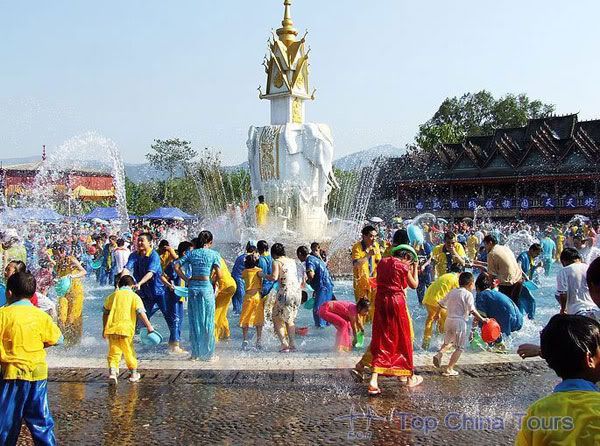
The Festival is itself a 3 day activity and it is in mid April every year. Visiting China , the Yunan Province during mid April can be an ideal choice to experience this festival.
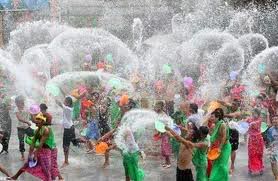
During this 3 days of festival, Blessings is being received by splashing water at each other. Besides Splashing of water at each other like nobody's business, there are interesting activities that can be taken part such as dragon boat matches , a lot of Singing and Dancing as well. A very merry making festival indeed.
The 3 days of celebrations is very rich and experiencing. It more than just about receiving blessings by splashing water or just mere merry making alone. It is also at the same time about romance as well too !
Eve
Before the festival, pigs and chickens are slaughtered and wines are brewed with foods which had been prepared beforehand. During the three days of the festival, rich and colorful activities are held. Dragon boat racing and other performances such as Peacock dance are held on the first day followed by the characteristic water-splashing event on the second day. The last day is usually for the young people to play games as a way of expressing their love for each other.
Usually held by the banks of the picturesque Lancang River (one of the main rivers of southwest China), girls of Dai ethnic minority dip branches into the river and sprinkle the water onto others as a way to express their best wishes at the beginning. The climax of the water-splashing activity is when the people of the different ethnic groups attending the festival splash water upon each other, using basins and buckets. Although all the people are soaked to the skin, all participants are happy
Day 1
On the first day, near the Lancangjiang River (澜沧江) There would be several Long Dragon Boats beautifully craved and decorated which are very well painted and dragon boat race is being held by the river.
When the race begins, the oars will role. People on the boat will shout out as loud as they can and it sounds loud enough to shake the sky. Near to the banks, supporters will cheer out loudly.
Bowls of rice wine willbe brought to the victor and candy will be cast onto them. The dancing of "Yilahe" happily companion the happiness of the victor together with the sounds of drums.
Day 2
The grandest day will be on the 2nd day. During the morning, all the men and woman, young and old will be carrying with them, buckets and basins to the streets.Many will by the riverside and under the shining sun, they would spray and splash water at each other like nobody's business and like never before at all who are participating in this grand meeting whether or not they know you or not.
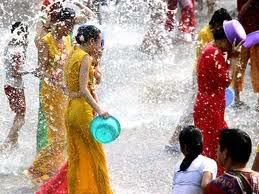
The person who is being sprayed or splashed the most will considered to be luckiest person.

Children would be having a lot of fun with water. Young girls will be usually thoroughly wet to their toes as it is by nature that guy will want to have girls as wet as possible and i am sure there no need to explain this. It is a very nice day where everyone will be having fun with water. Running around and playing with water.
In the evening,a grand entertainment party will be held whereby there will be people singing , dance, and setting off fireworks as well as guessing lantern riddles continuously till mid-night.
Day 3
On day 3 the programs are even richer. On this day, the most brilliant ones will be putting "Gaosheng", throwing pouch, and dancing peacock dance. So-called putting "Gaosheng" is that a ring of bamboo tubes tied up on the tops of long bamboo poles.
The bamboo tubes filled with gunpowder, which will fly into the sky suddenly with a loud crash. According to the customs, people must place five things symbolizing auspiciousness into the biggest "Gaosheng". The person who picks up these auspicious things will be lucky for the whole year.
In "Throwing Pouch", people divide into left, and right two rows, one side is fellows and the other is a girl. A pouch sewed with colorful cloth and decorated with two ribbons is flying to the fellows. Every time throwing a pouch, they will cheer with love.
Throwing pouch is the expression of paying court to each other for fellows and girls. The girls throw the pouch to the fellow whom she loves. The pouches are flying with the wished for beautiful future and the heart admiring love.
Myanmar/Burma
Next we shall proceed on to Myanmar / Burma
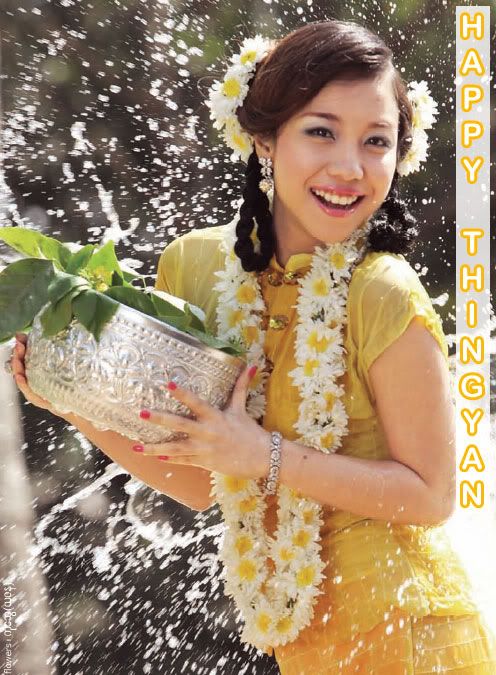
The eve of Thingyan, the first day of the festival called a-kyo nei, is the start of a variety of religious activities. Buddhists are expected to observe the Eight Precepts more than the basic Five Precepts, including having only one meal before noon. Thingyan is a time when uposatha observance days, similar to the Christian sabbath, are held. Alms and offerings are laid before monks in their monasteries and offerings of a green coconut with its stalk intact encircled by bunches of green bananas (nga pyaw pwè oun pwè) and sprigs of Tha byay or jambul (Syzygium cumini) before the Buddha images over which scented water is poured in a ceremonial washing from the head down. In ancient times Burmese kings had a hairwashing ceremony with clear pristine water from Gaungsay Kyun (lit. Headwash Island), a small rocky outcrop of an island in the Gulf of Martaban near Mawlamyaing
By nightfall, the real fun begins with music, song and dance, merrymaking and general gaiety in anticipation of the water festival. In every neighborhood pavilions or stages, with festive names and made from bamboo, wood and beautifully decorated papier mache, have sprung up overnight.

Local belles have been rehearsing for weeks and even years, in the run-up to the great event in song and dance in chorus lines, each band of girls uniformly dressed in colourful tops and skirts and garlanded in flowers and tinsel. They wear fragrant thanaka - a paste of the ground bark of Murraya paniculata which acts as both sunblock and astringent - on their faces, and sweet-scented yellow padauk blossoms in their hair. The padauk (Pterocarpus macrocarpus) blooms but one day each year during Thingyan and is popularly known as the "Thingyan flower".
Large crowds of revelers, on foot, bicycles and motorbikes, and in open top jeeps and trucks, will do the rounds of all the mandats, some making their own music and most of the womenfolk wearing thanaka and padauk. Floats, gaily decorated and lit up, also with festive names and carrying an orchestra as well as dozens of amorous young men on each of them, will roam the streets stopping at every mandat exchanging songs specially written for the festival including the Thingyan classics that everyone knows, and performing than gyat
It is indeed a time for letting go, a major safety valve for stress and simmering discontent. Generally however friendliness and goodwill prevail along with some boisterous jollity.
The next day called a-kya nei is when Thingyan truly arrives as Thagya Min makes his descent from his celestial abode to earth. At a given signal, a cannon (Thingyan a-hmyauk) is fired and people come out with pots of water and sprigs of tha byay, then pour the water onto the ground with a prayer. A prophesy for the new year (Thingyan sa) will have been announced by the brahmins (ponna) and this is based on what animal Thagya Min will be riding on his way down and what he might carry in his hand.Children vill be told that if they have been good Thagya Min will take their names down in a golden book but if they have been naughty their names will go into a dog book!

Serious water throwing does not begin until a-kya nei in most of the country although there are exceptions to the rule. Traditionally, Thingyan involved the sprinkling of scented water in a silver bowl using sprigs of tha byay (Jambul), a practice that continues to be prevalent in rural areas. The sprinkling of water was intended to metaphorically "wash away" one's sins of the previous year. In major cities such as Yangon, garden hoses, huge syringes made of bamboo, brass or plastic, water pistols and other devices from which water can be squirted are used in addition to the gentler bowls and cups, but water balloons and even fire hoses have been employed! It is the hottest time of the year and a good dousing is welcomed by most.
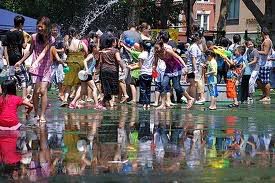
Everyone is fair game except monks and obviously pregnant women. Some overenthusiastic young lads may get captured by women, who often are their main target, and become kids of a practical joke with soot from cooking pots smeared on their faces. Maidens from mandats with dozens of garden hoses exchange hundreds of gallons of water with throngs of revelers and one float after another. Many revellers carry towels to block the jet of water getting into the ear and for modesty's sake as they get thoroughly soaked and drenched in their light summer clothes. The odd prankster might use ice water and a drive-by splash with this would provoke shrieks of surprise followed by laughs from its victims. Pwè (performances) by puppeteers, orchestras, dance troupes, comedians, film stars and singers including modern pop groups are commonplace during this festival.

The third day is called a-kyat nei and there may be two of them , an extra day in certain years. The fourth is known as a-tet nei when Thagya Min returns to the heavens, the last day of the water festival. Some would throw water at people late into the day making an excuse such as "Thagya Min left his pipe and has come back for it"! Over the long festive holiday, a time-honored tradition is mont lone yeibaw, glutinous rice balls with jaggery (palm sugar) inside thrown into boiling water in a huge wok and served as soon as they resurface which gave it the name.
All the young men and women help in making it and all are welcome, but watch out for some prankster putting a birdseye chilli inside instead of jaggery for a laugh! Mont let saung is another refreshing Thingyan snack, bits of sticky rice with toasted sesame in jaggery syrup and coconut milk. They are both served with grated coconut. In major cities such as Yangon and Mandalay, Rakhine Thingyan can also be experienced as Rakhine residents of the city celebrate in their own tradition. Water is scooped from a long boat (laung hlei) to throw at revelers and Rakhine mohinga is served.
The next day is New Year's Day ("hnit hsan ta yet nei"). It is a time for people to visit the elders and pay obeisance by gadaw (also called shihko) with a traditional offering of water in a terracotta pot and shampoo. Young people perform hairwashing for the elderly often in the traditional manner with shampoo beans (Acacia rugata) and bark. Many make new year resolutions, generally in the mending of ways and doing meritorious deeds for their karma.
Releasing fish (nga hlut pwè) is another time-honored tradition on this day; fish are rescued from lakes and rivers drying up under the hot sun, then kept in huge glazed earthen pots and jars before releasing into larger lakes and rivers with a prayer and a wish saying "I release you once, you release me ten times".Thingyan (a-hka dwin) is also a favourite time for shinbyu, novitiation ceremonies for boys in the tradition of Theravada Buddhism when they will join the monks (Sangha) and spend a short time, perhaps longer, in a monastery immersed in the teachings of the Buddha, the Dharma. It is akin to rites of passage or coming of age ceremonies in other religions.
On the new year's day, people make food donations (called "studitha") at various places. They typically provide free food to those participating in the new year's celebrations
Thailand
Next comes to Thailand
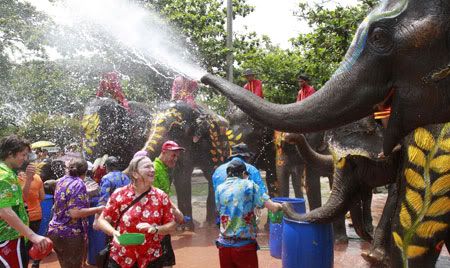
Typically, the water festival is known as Songkran in Thailand. People will roam the streets with containers of water or water guns or post themselves at the side of roads with a garden hose and drench each other and passersby. However, the main activity is more than just this. It is also about visiting and pay respects to elders, including family members, friends, neighbors, and monks.

Besides the throwing of water, people celebrating Songkran also go to a wat (Buddhist monastery) to pray and give food to monks. They cleanse Buddha images from household shrines by gently pouring water mixed with a Thai fragrance ( น้ำอบไทย) over them. It is believed that doing this will bring good luck and prosperity for the New Year.
New Year resolutions are also being made on refraining from bad behavior, or to do good things. Songkran is a time for cleaning and renewal. Besides washing household Buddha images, many Thais also take this opportunity to give their home a thorough cleaning
The throwing of water originated as a way to pay respect to people, by capturing the water after it had been poured over the Buddhas for cleansing and then using this "blessed" water to give good fortune to elders and family by gently pouring it on the shoulder.
The water is meant as a symbol of washing all of the bad away and is sometimes filled with fragrant herbs when celebrated in the traditional manner.
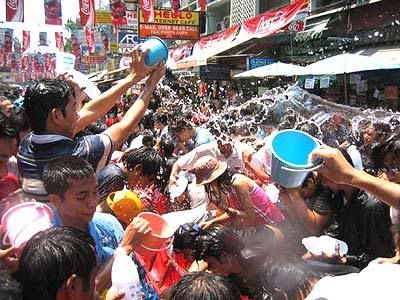
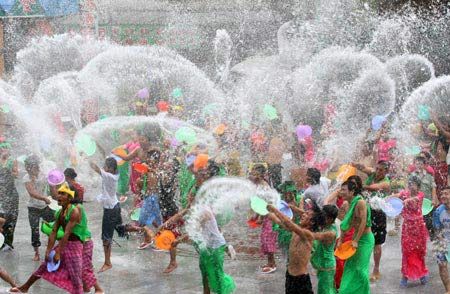
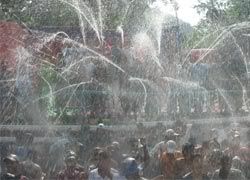
Songkran is also celebrated in many places with a pageant in which young women demonstrate their beauty and unique talents, as judged by the audience. The level of financial support usually determines the winner, since, to show your support you must purchase necklaces which you place on your chosen girl.
Laos
In Laos
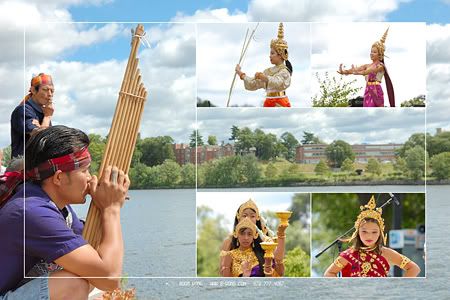
Lao New Year is the most widely celebrated festival in Laos. The festival is also celebrated by Laotians in the USA, Canada, France, and Australia. Lao New Year takes place in April, the hottest time of the year in Laos, which is also the start of the monsoon season. Lao New Year takes place at roughly the same time as Songkran in Thailand and Chaul Chnam Thmey in Cambodia.
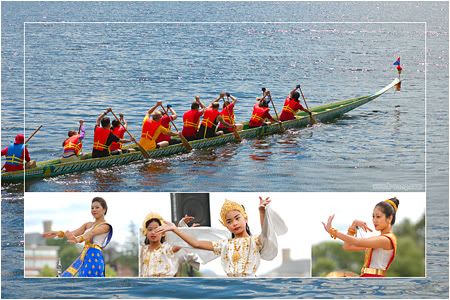
The official festival lasts for three days from April 13th to April 15th (although celebrations can last more than a week in towns like Luang Prabang). The first day is the last day of the old year. Houses and villages are properly cleaned on the first day. Perfume, water and flowers are also prepared for the Lao New Year. The second day of the festival is the "day of no day", a day that falls in neither the old year or the new year. The last day of the festival marks the start of the new year
Water
Pi Mai celebration, flour throwing
Water is used for washing homes, Buddha images, monks, and soaking friends and passers-by. Students first respectfully pour water on their elders, then monks for blessings of long life and peace, and last of all they throw water at each other. The water is perfumed with flowers or natural perfumes. Some people prefer flowers in the water to give a pleasant smell, as well as adding cologne/perfume. . Over the years another tradition has developed with Lao New Year: people will smear or throw cream (shaving cream or whipped cream) or white powder on each other during the celebrations.
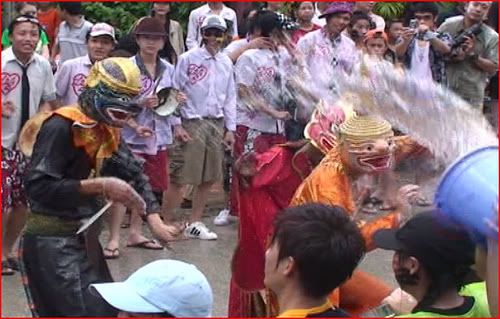
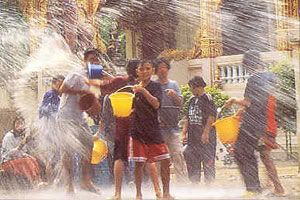
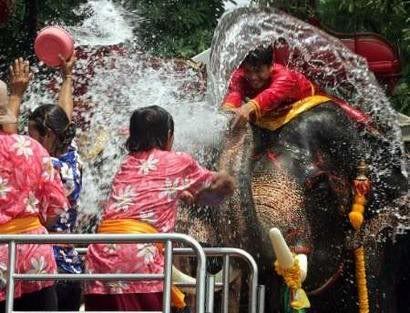
Sand
Sand is brought to the temple grounds and is made into stupas or mounds, then decorated before being given to the monks as a way of making merit. There are two ways to make the sand stupas. One way is to go to the beach, and the other way is to bring sand to the wat, or pagoda. Sand stupas are decorated with flags, flowers, white lines, and splashed with perfumed water. Sand stupas symbolize the mountain, Phoukao Kailat, where King Kabinlaphom's head was kept by his seven daughters.
Animals
Another way to make merit at this time is to set animals free. The Lao believe that even animals need to be free. The most commonly freed animals are tortoises, fish, crabs, birds, eels, and other small animals.
Flowers
Flowers are gathered to decorate Buddha images. In the afternoons people collect fresh flowers. Senior monks take the younger monks to a garden filled with flowers, where they pick flowers and bring back to the wat to wash. People who didn't participate in the flower picking bring baskets to wash the flowers so the flowers can shine with the Buddha statues.
Beauty pageant
There is an annual beauty pageant in Luang Prabang to crown Miss Bpee Mai Lao (Miss Lao New Year). There are many beauty pageants in Laos, but Luang Prabang - the old capital - is widely known for its Nangsoukhane pageant. There are seven contestants, each one symbolizing one of King Kabinlaphom's seven daughters.
Music and dance
During Lao New Year, there are many spectacles including traditional Lao music, mor-lam, and lam-wong (circle dancing). During the daytime almost everybody is at the temple worshipping, hoping to have a healthier and happier life in the new year. During the evening, people of all ages go to the wat for entertainment.
Cambodia
In Cambodia

The Cambodia Water Festival or ‘Bon Om Tuk’ in Khmer is the largest festival in the Cambodian calendar and an amazing sight to behold! The 3-day Water Festival in Phnom Penh is of great significance as it celebrates the end of the rainy season, the start of the fishing season, and also the unique natural phenomenon - the flow of the Tonle Sap river changing direction! And not only this, the Cambodia Water Festival also coincides with the full moon of the Buddhist calendar month of Kadeuk, this full moon is traditionally a good omen promising a bountiful harvest.

This festival is a national event, as many villagers throughout the country have spent almost a full year preparing their villages boat – elaborately and brightly decorated dug out canoes with large eyes on the prows to ward off evil spirits. Thousand of Khmers descend on Phnom Penh over the three days to watch the races and cheer on their villages boat, which can be up to 20 meters long and contain up to 60 oarsmen, frantically paddling and chanting as the do battle in highly competitive races.
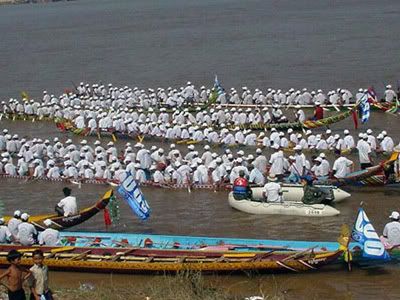
The origins of the Water Festival dates back to the powerful navy of King Jayavarman II, the 9th century founder of the great Angkorian Empire, and the main purpose is to make the god of the river happy so he will provide many fish and the rice crop will be plentiful.
During this time Phnom Penh takes on a carnival atmosphere, and as well as the river banks being lined with exuberant spectators there are also live concerts, hundreds of food stands, games of chance, fair rides, and at night fireworks light up the sky and people dance in the street.
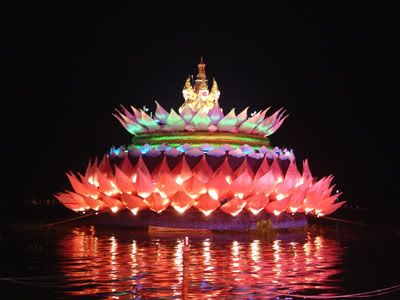
On this day, the boats race in pairs along a kilometer-long course, and then in the evening brightly decorated floats cruise along the river prior to and during the nightly fireworks displays.
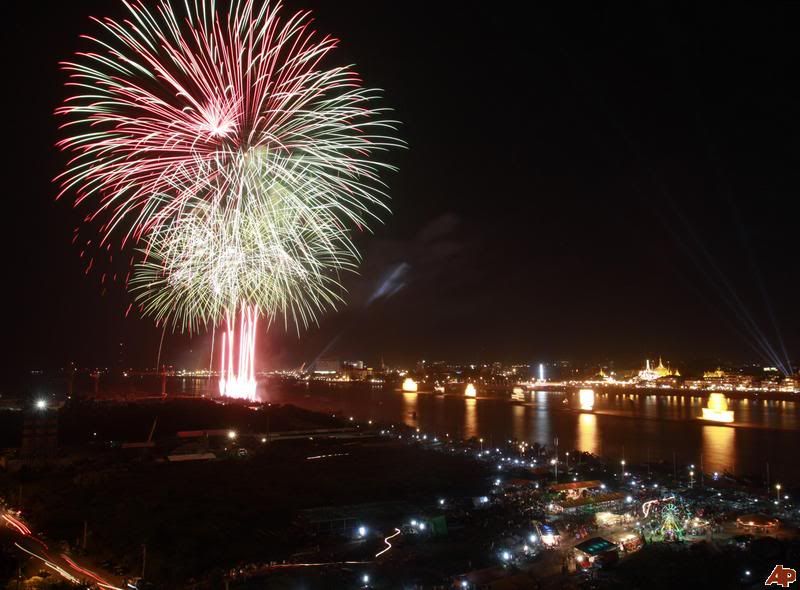
There is often a parallel festival at Angkor Wat and although it is smaller in scale it is just as impressive due to the backdrop of Angkor Wat.
The festival marks the changing of the flow of the Tonle Sap River and is also seen as thanksgiving to the Mekong River for providing the country with fertile land and abundant fish. It is at this time when the river flow reverts to its normal down-stream direction. In a remarkable phenomenon, the Tonle Sap River earlier reverses its course as the rainy season progresses, with the river flowing "upstream" to Tonle Sap Lake. Then as the rainy season tapers off, the river changes direction once again as the swollen Tonle Sap Lake begins to empty back into the Mekong River, leaving behind vast quantities of fish.
Singapore
Water festival Singapore
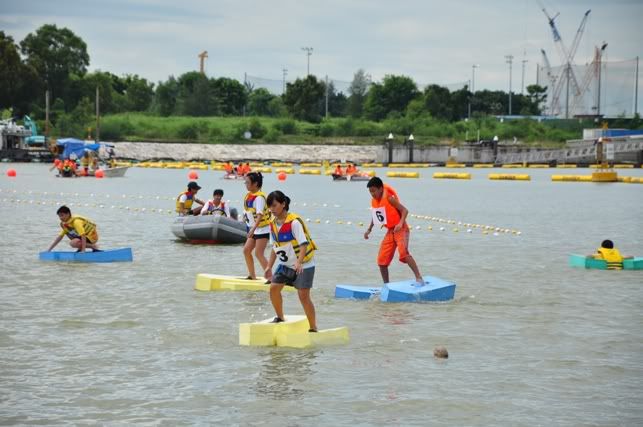
With the objective of bringing the young people together, Singapore in the very recent years came up with their very own water festival uniquely, Singapore !
This Water Festival is known be as the : Singapore International Water Festival (SIWF) acting as a platform to bring the young together and to celebrate her achievements in the world of water since the year of 2009.
At the same time through this festival, people in Singapore are being educated and reminded continuously about management of water resources in schools, institutions , industrial , commercial and water problems are being address to as well in the constant amidst changing environment that Singapore has.
Much water related activities and games will be held this day and the venue will like places such as the Kallang River, Marina Bay sands, Marina Barrage Clarke Quay etc..
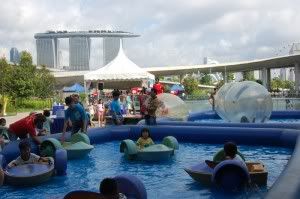
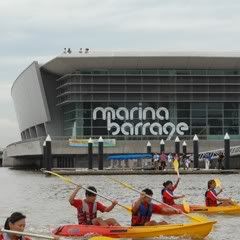
You may like to read up more in the links provided below
As Singapore is itself a land of immigrants and has a long history of migrants, Foreigners do celebrate their own water festival in Singapore and the locals do join in the fun with these migrants.
Click on the links below to learn more.
Foreigners celebrating water festival in Singapore
Thanks for the well written and complete explanation of our truly Asian festival. :)
ReplyDeleteThis is awesome, share more.You can increase your butts, boobs and hips today with the best Pmma buttock injection artefill and Creams coupled with an amazing Hydrogel buttock injection 1000cc Online for a great sexy body shape butts and boobs lift creams Macrolane buttock injections 1500cc you can as well whatsapp+14013083901 for more details and to book an appointment for our doctors
ReplyDelete